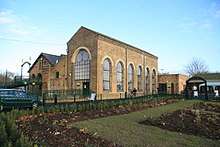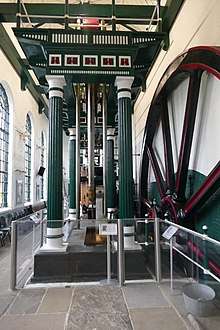Markfield Beam Engine and Museum
Markfield Road Pumping Station, now known as Markfield Beam Engine and Museum or sometimes just as Markfield Beam Engine is a Grade II listed building containing a 100 horsepower (75 kW) beam engine,[1] originally built in 1886 to pump sewage from Tottenham towards the Beckton Works.[2] The grounds of the building now form a public park known as Markfield Park.[3]
| Markfield Road Pumping Station | |
|---|---|
 | |
| Location | Tottenham London, N15 United Kingdom |
| OS grid reference | TQ 34410 88782 |
| Built | 1886 |
| Original use | Sewage treatment |
| Current use | Museum |
| Website | www.mbeam.org |
Listed Building – Grade II | |
| Designated | 1974 |
| Reference no. | 1358862 |
 Location of Markfield Road Pumping Station in London Borough of Haringey | |
Markfield Beam Engine
Markfield Beam Engine is a free-standing steam engine with a 27 feet (8.2 m) flywheel that moves a 21 feet (6.4 m) beam. The beam drives two single-acting plunger pumps. Each pump is 26 inches in diameter and has a 51-inch stroke. When the machine was operational it had a working speed of 16 rpm and each pumps could move 2,000,000 imperial gallons (9,100,000 l; 2,400,000 US gal) a day.[4][5]
The engine is finely decorated, with doric style columns and acanthus leaves.
History

The sewage works opened in 1864 - the engine was built in 1886 and commissioned in 1888, it was used continuously from then until 1905, when it was relegated to occasional duty for stormwater pumping. The works were finally closed for operation in 1964.[2]
Over £3 million has been spent on restoring the engine, building and surrounding grounds, a full restoration of the park was completed by April 2010, and the park, museum, and beam engine re-opened for public access. The funding was secured through various sources including the Heritage Lottery Fund, Football Foundation, DCLG and Big Lottery Fund.[3] The engine is now occasionally run for public display.[6]
See also
| Wikimedia Commons has media related to Markfield Road pumping station. |
References
- Historic England. "Pumping Station Building and Engine". Retrieved May 2016. Check date values in:
|access-date=(help) - A P Baggs; Diane K Bolton; Eileen P Scarff; G C Tyack (1967). A History of the County of Middlesex. 5. London: Victoria County History. pp. 345–348. Retrieved May 2016. Check date values in:
|access-date=(help) - Haringey Council. "Markfield Park". Retrieved May 2016. Check date values in:
|access-date=(help) - Markfield Beam Engine and Museum. "The Engine". Retrieved May 2016. Check date values in:
|access-date=(help) - Friends of Markfield Park. "About Markfield Park". Retrieved May 2016. Check date values in:
|access-date=(help) - Haringey Council. "Markfield Beam Engine and Museum". Retrieved May 2016. Check date values in:
|access-date=(help)